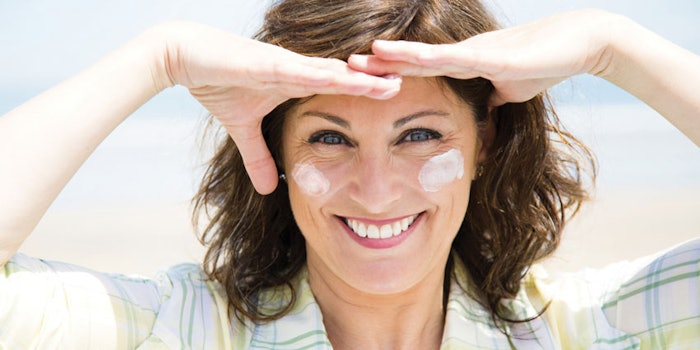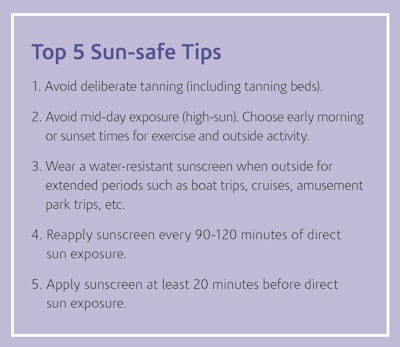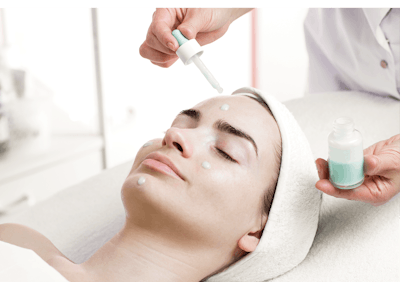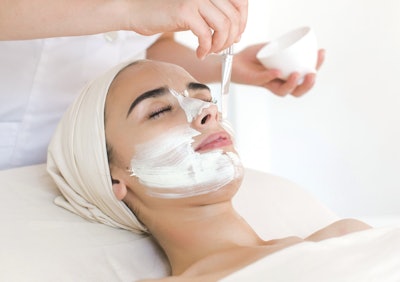
In part one of this series, the symptoms, causes and differences of intrinsic (birthday) aging and extrinsic (environmental and sun damage) aging were discussed. Most clients will have both types of aging skin, and the severity will vary based on the amount of sun exposure they have experienced. Everyone over 30 years old will have some sign of intrinsic aging, primarily expression lines. These first appear in the outer eye areas and forehead, and eventually the nasalabial folds. The age at which sun damage appears depends on the Fitzpatrick skin type and the amount of cumulative sun exposure in the individual client.
Sunscreen
By far, avoidance of sun and the daily use of sunscreen is the number one technique in preventing the appearance of aging skin. Ideally, everyone should be using a daily sunscreen when approved for sunscreen usage at six months old. It is the daily use of sunscreen that helps ward off the appearance of aging (see Top 5 Sun-safe Tips).
If you compare the skin of a 50 year old who does not wear daily sunscreen to someone who has worn daily sunscreen for years, there is a dramatic difference. As a skin therapist, it should be a true priority to make sure all your clients are educated about the devastating effects of sun on the skin. It should be stressed that this damage is cumulative, like termites destroying a house. You don’t see the damage at first until enough has accumulated to begin showing.
 Every skin therapist should stock and sell a variety of sunscreen products. They should all be SPF 15 or higher, and should all be tested broad-spectrum. Most cosmetic scientists now believe that a broad-spectrum rating is more important than a high SPF. Helping to shield from both UVA and UVB will not only prevent sunburn, but also help prevent skin cancers and the damage caused by deep-penetrating UVA rays. Many scientists also believe that high SPF claims (50+) are mostly hype and that the extent of sun shielding is not substantially increased.
Every skin therapist should stock and sell a variety of sunscreen products. They should all be SPF 15 or higher, and should all be tested broad-spectrum. Most cosmetic scientists now believe that a broad-spectrum rating is more important than a high SPF. Helping to shield from both UVA and UVB will not only prevent sunburn, but also help prevent skin cancers and the damage caused by deep-penetrating UVA rays. Many scientists also believe that high SPF claims (50+) are mostly hype and that the extent of sun shielding is not substantially increased.It is important to have sunscreens that work well under makeup, with moisturizing ingredients so the client does not have to use two products. There is no reason to have to use moisturizer prior to sunscreen. We have the technology to combine these two products, and it makes it much more convenient for the client.
Make sure to have several different weights of sunscreen suitable for different skin types. Oily skin needs a matte sunscreen whereas dry skin needs a sunscreen with humectants and lipids to hold essential moisture. For sensitive skin, carry a sunscreen that has been sensitive-skin tested that also contains soothing and anti-redness ingredients. Your client should fall in love with their sunscreen. It needs to be protective, the right weight for each client and suitable for their lifestyle and individual needs.
Antioxidants
Sun exposure and inflammation cause the production of reactive oxygen species (ROS), which are oxygen-based molecules that wreak havoc on the skin and physiological processes. Commonly known as free radicals, these destructive structures trigger the production of “self-destruct” enzymes in the skin. Collagenase, elastase and hyaluronidase are enzymes that break down collagen and elastin fibers and supportive hyaluronic acid in the dermis. Cumulative damage to these structural skin components eventually causes wrinkling, elastosis, lack of firmness and other visible signs of sun-induced skin aging.
 Antioxidants are ingredients that interfere or stop biochemical reactions triggered by the ROS. There are many different types of antioxidants for topical use; some of the popular ones include vitamins C and E, grapeseed extract, green tea extract, superoxide dismutase (SOD), malachite extract, lichochalcone, resveratrol, types of plant stem cells and many others. Antioxidants are fragile ingredients and must be carefully formulated so that they remain stable until they are used. Often in serum form, these agents should be used daily under sunscreen for the best protective results. Antioxidants are often combined with other age management performance ingredients in more high-tech serums.
Antioxidants are ingredients that interfere or stop biochemical reactions triggered by the ROS. There are many different types of antioxidants for topical use; some of the popular ones include vitamins C and E, grapeseed extract, green tea extract, superoxide dismutase (SOD), malachite extract, lichochalcone, resveratrol, types of plant stem cells and many others. Antioxidants are fragile ingredients and must be carefully formulated so that they remain stable until they are used. Often in serum form, these agents should be used daily under sunscreen for the best protective results. Antioxidants are often combined with other age management performance ingredients in more high-tech serums.Ceramides
As discussed in part one of this article, young skin has a plentiful amount of lipids between the skin cells in the epidermis. This fatty lipid complex, known as the barrier function or interstitial lipid complex or intercellular cement, is the material that fills spaces between epidermal cells. The barrier lipids are responsible for holding adequate moisture in the outer skin, guarding against skin moisture loss and acting as a protective barrier to stop potential irritants from penetrating the outer skin. Aesthetically, the barrier lipids provide surface smoothness, firmness, lack of hydration and are a major force in reducing redness by preventing inflammation from irritants.
These intercellular lipids are produced by the skin during the skin renewal process. As skin gets older, the cell renewal slows and so does the production of this important lipid complex. When lipid production is not sufficient, the skin does not hold on to moisture as well, resulting in dehydration, changes in outer firmness, accentuated wrinkles and lines, rough skin textures, general dryness and a dull appearance to the complexion. Skin can also become more sensitive and redness-prone due to lack of sufficient protection.
Lipid replacement ingredients, often called ceramides, are lipid ingredients that can be added to formulas to help aging and dry skin. Ceramides penetrate the skin surface and “patch the mortar” where lipids are deficient in quantity. Ceramides can be blended into many skin care products including hydrating lotions, serums, sunscreens, eye crèmes, masks and other preparations for age management. Their effects are almost immediate and provide dry skin relief, decreased irritation potential and, when used regularly, improvement in the appearance of wrinkles, firmness, and elasticity.
AHAs
There are numerous performance ingredients that accelerate cell turnover in the epidermis. Alpha hydroxy acids (AHAs) are a great example of these. The alpha hydroxy family of acids includes glycolic acid, lactic acid, mandelic acid, malic acid and tartaric acid. When used in the proper concentration in a serum or lotion, AHAs trigger and stimulate increased cell renewal. Removing surface dead, dry, dehydrated cells, AHAs almost immediately improve the appearance of mature or dry skin.
When the outer dead cells are removed, cell renewal is triggered. The newer cells are fresher and make the skin surface younger-looking. As the cell renewal speeds up, so does the production of interstitial lipids. So, AHAs don’t just exfoliate the dull, dry surface cells, but they actually trigger production of moisture-binding lipids that help support a younger looking appearance of smoother, firmer skin with improved texture.
Actives
The ingredients that cause skin stimulation affect the skin in ways that can show significant appearance changes. These include retinol, niacinamide, peptides, botanical stimulants and cellular stimulants like resveratrol. Although all of these work differently, they all stimulate activity in the skin cells, increasing collagen production, and all show improvement in the appearance of aging. Some of these stimulants can have side effects of redness and require careful use and introduction, but they do produce results in improvement of the aging skin appearance.
Combining Ingredients
 Ingredients in aging skin care may be compared to instruments in an orchestra. They all have a unique function and differ in their offerings, but they produce an amazing effect when combined. It is the job of the skin therapist to carefully evaluate the client’s individual skin needs, as well as lifestyle needs, before designing a care program with the right combination of performance ingredients to promote positive changes in the appearance of the client’s skin. Speaking of lifestyle needs, smoking is probably the worst thing you can do to your body and has horrendous effects on both the body and the skin. Advise clients not to smoke!
Ingredients in aging skin care may be compared to instruments in an orchestra. They all have a unique function and differ in their offerings, but they produce an amazing effect when combined. It is the job of the skin therapist to carefully evaluate the client’s individual skin needs, as well as lifestyle needs, before designing a care program with the right combination of performance ingredients to promote positive changes in the appearance of the client’s skin. Speaking of lifestyle needs, smoking is probably the worst thing you can do to your body and has horrendous effects on both the body and the skin. Advise clients not to smoke!To learn more about the differences between intrinsic and extrinsic aging, be sure to check out the first part of this article: Birthday Aging or Sun Damage? A Tale of Two Sisters.












